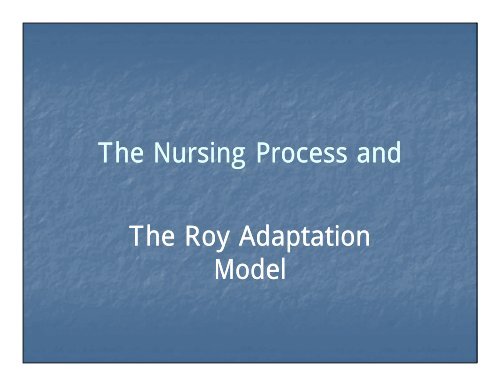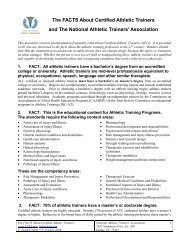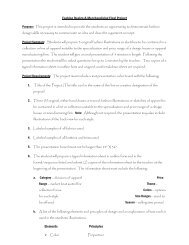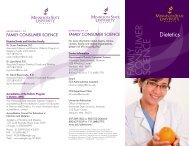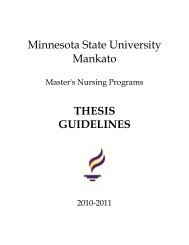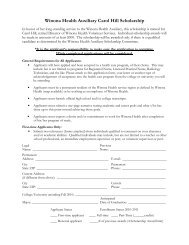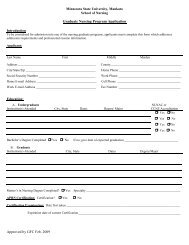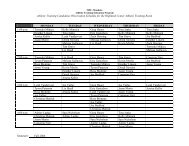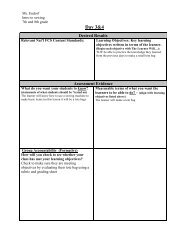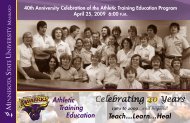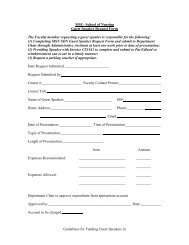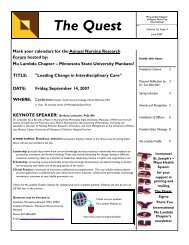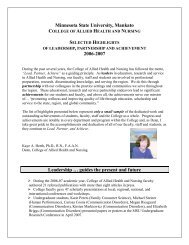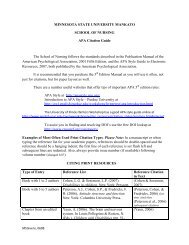The Nursing Process and The Roy Adaptation Model
The Nursing Process and The Roy Adaptation Model
The Nursing Process and The Roy Adaptation Model
You also want an ePaper? Increase the reach of your titles
YUMPU automatically turns print PDFs into web optimized ePapers that Google loves.
<strong>The</strong> <strong>Nursing</strong> <strong>Process</strong> <strong>and</strong><br />
<strong>The</strong> <strong>Roy</strong> <strong>Adaptation</strong><br />
<strong>Model</strong>
<strong>The</strong> <strong>Roy</strong> <strong>Adaptation</strong> <strong>Model</strong><br />
• <strong>Nursing</strong> model – a model is an idea that<br />
explains by using symbolic <strong>and</strong> or physical<br />
visualization. Can be verbal, schematic, or<br />
quantitative (math symbol)<br />
• Basis from which nursing curriculum is<br />
developed<br />
• Basis for making nursing judgments<br />
regarding clinical experiences<br />
• Framework on which a nurse makes<br />
decisions regarding patient care
<strong>The</strong> RAM was developed by Sister<br />
Callista <strong>Roy</strong><br />
• <strong>The</strong> recipient of nursing care is a biopsychosocial<br />
(spiritual) being or group in constant interaction<br />
with the environment. Open system<br />
• Goal - the promotion of adaptation for<br />
individuals id <strong>and</strong> groups in each of the four<br />
adaptive modes, thus contributing to health,<br />
quality of life, <strong>and</strong> dying with dignity.<br />
• Nurse’s activity - uses the nursing process to<br />
promote adaptation in each of the adaptive<br />
modes.
<strong>Adaptation</strong><br />
• the process <strong>and</strong> outcome whereby<br />
thinking <strong>and</strong> feeling persons, as<br />
individuals or in groups, use conscious<br />
awareness <strong>and</strong> choice to create human<br />
<strong>and</strong> environmental integration
Adaptive mechanisms: individual<br />
id Are mechanisms that help a person cope mentally,<br />
physically, socially, spiritually <strong>and</strong> emotionally<br />
• Regulator subsystem: responds automatically – neural,<br />
chemical <strong>and</strong> endocrine, stimuli come from the senses<br />
• Cognator subsystem: respond through four cognitive-<br />
emotional channels<br />
Perceptual <strong>and</strong> information processing<br />
learning<br />
judgment<br />
emotion
Adaptive mechanisms: Group<br />
• Innovator subsystem: Structures <strong>and</strong> processes<br />
for change <strong>and</strong> growth. Focuses on change.<br />
Think about families<br />
• Stabilizer subsystem: Establishes structures,<br />
values <strong>and</strong> daily activities. Family roles/rules –<br />
who does what? Example – mom is on strike, is<br />
the family stabilized?<br />
Focus is on system maintenance
<strong>Adaptation</strong> level<br />
el<br />
• a changing point influenced by the<br />
situation <strong>and</strong> the internal resources of the<br />
person, family or group. <strong>The</strong> three levels<br />
of adaptation are:<br />
• Integrated life process<br />
• Compensatory process<br />
• Compromised process
Integrated life process<br />
• level at which<br />
the structures<br />
<strong>and</strong> functions of<br />
a life process are<br />
working as a<br />
whole to meet<br />
human needs.
Compensatory process<br />
• level at which<br />
coping mechanisms<br />
(cognator <strong>and</strong><br />
regulator) have<br />
been activated by a<br />
challenge to the<br />
person or group
Compromised omised process<br />
• level resulting<br />
from inadequate<br />
integrated <strong>and</strong><br />
compensatory<br />
life processes;<br />
an adaptation<br />
problem
Four adaptive modes<br />
• Three psychosocial <strong>and</strong> one physiologic<br />
mode. All impact each other like marbles.<br />
• Based on basic needs<br />
• Need - a requirement within an individual<br />
or group which stimulates a response to<br />
maintain integrity
Individual id Self-concept<br />
Psychic <strong>and</strong> spiritual integrity: the need to know<br />
who one is<br />
• Physical self<br />
Body sensations<br />
Body image: loss<br />
• Personal self<br />
Self-consistency: anxiety<br />
Self-ideal: powerlessness<br />
Moral-ethical<br />
ethical-spiritual self: guilt<br />
All Contribute to our self esteem
Go Group pselfconcept<br />
self-concept<br />
Identity integrity/group identity<br />
• Interpersonal relationships<br />
• Group self-image<br />
• Social milieu<br />
• Culture
Individual id Role function<br />
Need is social integrity – the need to know who<br />
one is in relation to others so that one can act.<br />
• Role set: All of the roles a person holds at one<br />
time.<br />
• Instrumental behaviors: goal orientated<br />
behavior, role activities, i i student – studying,<br />
di<br />
mother – rocking a crying baby<br />
• Expressive behaviors<br />
– feelings <strong>and</strong> attitudes<br />
held by the person about performing the role<br />
• Requirements <strong>and</strong> other stimuli – consumer,<br />
reward, access to facilities <strong>and</strong> circumstances,<br />
cooperation <strong>and</strong> collaboration
Group Role Function<br />
• Role clarity; the need to underst<strong>and</strong> <strong>and</strong><br />
commit to fulfill expected tasks, so that<br />
the group can achieve common goals.<br />
• Aggregate role set – all roles within a<br />
group. Complement of roles within a group.<br />
• Developmental stage – add new roles as we<br />
develop or mature
Interdependence - Individual<br />
id • Relational integrity: feeling of security in<br />
nurturing relationships.<br />
• Mode focuses on interactions related to<br />
the giving <strong>and</strong> receiving of love, respect<br />
<strong>and</strong> value<br />
• Significant others<br />
• Support systems
Group Interdependence<br />
Social context in which the group operates<br />
• Context<br />
• Infrastructure<br />
• Participants<br />
i t
Individual physiologic mode:<br />
Needs/Complex <strong>Process</strong>es<br />
• Oxygenation - need<br />
• Nutrition - need<br />
• Elimination i - need<br />
• Activity <strong>and</strong> rest - need<br />
• Protection - need<br />
• Senses – complex process (CP)<br />
• Fluid, electrolyte, <strong>and</strong> acid-base balance - (CP)<br />
• Neurologic function - (CP)<br />
• Endocrine function - (CP)
<strong>Adaptation</strong> problems<br />
• occur in each adaptive mode when<br />
satisfaction of needs is not possible
Responses<br />
• Adaptive response - behavior that<br />
promote integrity in terms of the goals of<br />
human systems. Example: You run up the<br />
stairs to get your jacket, your pulse <strong>and</strong><br />
respiratory rate increase to meet bodies<br />
needs<br />
• Ineffective response - behavior that does<br />
not contribute to the integrity of the<br />
individual or group. Example: denial or a<br />
rapid irregular pulse at rest
<strong>Nursing</strong> Actions/<strong>Nursing</strong> sing <strong>Process</strong><br />
• <strong>Nursing</strong> process is ADPIE<br />
• <strong>Roy</strong> separates Assessment into two<br />
distinct phases:<br />
First level assessment of behavior<br />
Second level assessment of stimuli
First level el assessment<br />
• Identify behaviors in each of the<br />
adaptive modes. Internal or external<br />
actions <strong>and</strong> reactions under specified<br />
circumstances.<br />
• Physiologic-physical<br />
• Self-concept<br />
concept-group identity<br />
• Role function<br />
• Interdependence
Behaviors<br />
• Identified through nursing history <strong>and</strong> physical<br />
(see pages 5-9) <strong>and</strong> ongoing assessments. We<br />
cluster them together in the 4 modes.<br />
• Identify <strong>and</strong> label if they are:<br />
• Subjective behaviors (s): symptoms. Ex. Aching pain<br />
in left knee<br />
• Objective behaviors (o): signs Ex. Temperature 101.4<br />
• Identify if they are:<br />
• Adaptive (A), that is promote integrity<br />
• Ineffective (I), do not promote integrity or integrity<br />
will be compromised.
Second Level el Assessment<br />
• Identify stimuli or influencing factors<br />
causing the behaviors assessed. Three<br />
types of stimuli:<br />
• Focal<br />
• Contextual<br />
• Residual
Focal Stimuli<br />
• <strong>The</strong> internal or external stimulus most<br />
immediately confronting the person for that<br />
cluster of behaviors. <strong>The</strong>y focus on it.<br />
• Is not the medical diagnosis.<br />
• It must be something nursing can do something<br />
about.<br />
• When you look at a nursing diagnosis it is the<br />
related to phrase<br />
• Impaired physical mobility r/t abdominal incision pain<br />
• Anxiety r/t feelings of hopelessness <strong>and</strong> helplessness<br />
secondary to new breast cancer diagnosis
Contextual t Stimuli<br />
• All other stimuli present in the situation that<br />
contribute to the effect of the focal stimulus<br />
• Can be internal or external<br />
• Can have a positive or negative effect<br />
• We must know or have confirmed their influence on<br />
the situation.<br />
• Examples: past experiences, other health conditions,<br />
age, gender, culture, spirituality, level of physical<br />
function, family dynamics, economic status,<br />
knowledge base, values, support systems in place
Residual Stimuli<br />
• Environmental factors in or out of the person,<br />
effects are not clear in the current situation.<br />
• <strong>The</strong>y are often a “hunch” based on our<br />
knowledge or past experiences with clients with<br />
similar il problems.<br />
• If we confirm that the stimuli is influencing we<br />
move it to either F or C stimuli<br />
• Categories are similar to contextual
Active learning: label l the behaviors<br />
• “I feel really nauseous”<br />
• Slightly decreased skin turgor over sternum<br />
• Dry oral mucous membranes<br />
• Temperature 98.2 (o)<br />
• 3 liquid light brown stools in the last 2 hours<br />
• No vomiting in the last hour<br />
• Ate 2 bites of jello <strong>and</strong> 2 oz of broth at lunch<br />
• 200 cc dark amber urine in last 8 hours<br />
• I’m having really bad cramps<br />
• “I just have no energy” “I’m so tired”<br />
• “I don’t have time for this, I have so much I have to get done”<br />
• Abdomen slightly rounded, d no tenderness with palpation<br />
• Hyperactive bowel sounds in all four quadrants<br />
• Skin pale, warm, slightly diaphoretic<br />
• Serum Na 135, Serum K 3.8
Develop elop a nursing care plan<br />
• A care plan is holistic <strong>and</strong> identifies actual<br />
<strong>and</strong> potential problems in each of the four<br />
modes. One care plan may have 20<br />
problems or diagnoses identified.<br />
• diagnosis<br />
• goals/outcomes<br />
• interventions with rationale<br />
• evaluation
• Nurse will manipulate or manage stimuli,<br />
hopefully eliminate or modify the focal<br />
stimulus if the behavior is ineffective.<br />
• If behavior is adaptive, the nurse will<br />
reinforce or support this behavior.
interrelatedness elatedness of the modes<br />
• An individual or a<br />
group function as a<br />
whole that is more<br />
than a sum of its<br />
parts<br />
• Each adaptive mode<br />
may act as a focal,<br />
contextual, t or residual<br />
stimulus for another<br />
mode.
<strong>Nursing</strong> <strong>Process</strong> <strong>and</strong> RAM in a nutshell<br />
• 1 st level assessment: Assess Behaviors ie the what<br />
• 2 nd level assessment: Identify stimuli, ie the why<br />
• Diagnosis: What does it all mean?<br />
• Planning: What do you want them to do?<br />
• Implementation: What are you going g<br />
to do about it?<br />
<strong>Nursing</strong> intervention number 1 is how you are going to<br />
help them meet goal number 1<br />
• Evaluation: How did it work out, , what do you need to<br />
keep or change?
Student Nurse versus Professional<br />
Nurse Care Plans<br />
• When students do a “care plan” they are only addressing<br />
one problem. In contrast, a professional care plan is<br />
holistic ie has all identified actual <strong>and</strong> potential problems<br />
on it.<br />
• Student care plans will have the entire nursing process<br />
on it with the addition of rational. <strong>The</strong>y have to tell us<br />
why you are doing specific nursing interventions, entions ie the<br />
scientific basis.<br />
• A professional care plan document begins with the<br />
nursing diagnosis. Assessment data is in the nursing<br />
history <strong>and</strong> physical, assessment notes <strong>and</strong> narrative<br />
notes.
Student Nurse versus Professional<br />
• In the stimuli columns:<br />
Nurse Care Plans<br />
• Focal stimuli: Students need to do a mini patho tree<br />
of the problem. Start with the secondary to piece<br />
<strong>and</strong> work towards the r/t piece.<br />
• Contextual stimuli: they can not just name it they<br />
have to briefly explain it.<br />
Ex: do not just say religious beliefs, would say Follows<br />
Catholic doctrine – can not eat meat on Fridays<br />
during lent.<br />
Ex: don’t say pain tolerance. Quantify it, do they<br />
have a high, moderate or low pain tolerance.


